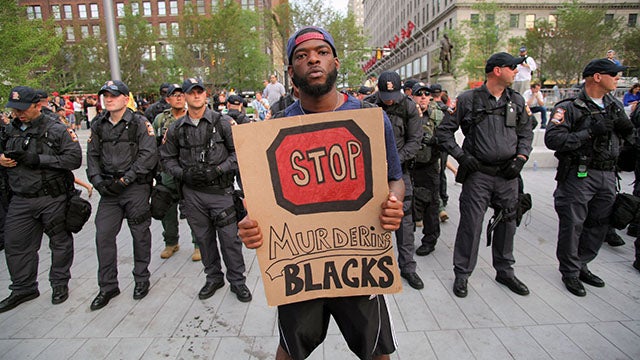As we approach another Fourth of July, millions of people in the United States are questioning what it means to be an American. The country has spent the last few months in a national reckoning over structural racism and violence against individuals and communities of color, and specifically Black Americans.
One cannot be truly literate in American identity and ideals without understanding the various forms of racial injustice in this country. Some are all too familiar due to their lived experiences. Those who are not, particularly white Americans, should make a deliberate effort to understand these historical and modern realities.
Establishing a shared understanding of the breadth of American experiences is one step toward dismantling white supremacy and systems of racial oppression coded into this nation’s fibers. It is also an antidote to the dangerous fragmentation we are experiencing today. This is the premise of an initiative called What Every American Should Know. As part of the initiative, the following is a curated list of ten terms and references that every American should know to more fully understand the manifestations of race, racism, and racial injustice in this country, and therefore, to better understand the full American experience. It was created by the Institute’s Citizenship and American Identity Program in collaboration with the Center for Native American Youth and the Latinos and Society Program.
1. Merciless Indian Savage
Most Americans are aware that the Declaration of Independence states that “We hold these truths to be self-evident that all men are created equal.” Yet in the following lines the document refers to Native Americans—the first inhabitants and stewards of this land—as “merciless Indian Savages, whose known rule of warfare, is undistinguished destruction of all ages, sexes and conditions.” Indians were not meant to be treated as equal to “all men,” but were considered subhuman. We must not celebrate American ideals on the Fourth of July without also acknowledging the reality that this land was colonized by means of dehumanizing, stealing from, enslaving, and committing cultural genocide against Indigenous peoples. This includes the many battles against and forcible removal of Indian people from their traditional land like the Battle of Wounded Knee, the Battle of Steptoe, the Battle of Little Big Horn, Indian Removal, and the Trail of Tears. The words “merciless Indian Savages” form the roots of white supremacy in America—we must confront its legacy.
2. “What to the Slave is the Fourth of July?” by Frederick Douglass
“What to the Slave is the Fourth of July” was a speech given by Frederick Douglass on July 5, 1852 at an Independence Day celebration, in which he highlighted the hypocrisy of promoting the ideals of “life, liberty and the pursuit of happiness” while other people were enslaved on the same soil: “…Fellow-citizens, pardon me, allow me to ask, why am I called upon to speak here to-day? What have I, or those I represent, to do with your national independence? Are the great principles of political freedom and of natural justice, embodied in that Declaration of Independence, extended to us?” With this in mind, many Americans are advocating for Juneteenth, also known as Emancipation Day, to be honored with as much significance as the Fourth of July.
3. Japanese American Internment
During World War II, the United States government under President Roosevelt forced approximately 120,000 Japanese Americans to be interred in isolated camps in an effort to limit espionage on US soil. Japanese Americans also faced hostility from fellow Americans upon leaving the camps and attempting to resume their former lives. President Ford issued a formal apology to the internees in 1976, and Congress authorized the payment of reparations in 1988. Still, the internment of Japanese Americans remains one of the most atrocious violations of civil rights in modern history.
4. “Letter from Birmingham Jail” by Dr. Martin Luther King, Jr.
After being arrested for participating in a non-violent protest as part of the civil rights movement, Dr. Martin Luther King Jr. wrote “Letter from Birmingham Jail” on April 16, 1963, from the city jail in Birmingham, Alabama. In his letter, Dr. King responds to a narrative calling his protests “unwise and untimely,” articulating that people have a moral responsibility to break unjust laws and to take direct action rather than waiting for justice to come through the courts. Today, in the wake of George Floyd’s killing, as Americans grapple with systemic racism, King’s words are as important as ever.
5. Chicano Movement
Alongside the Civil Rights Movement of the 1960s was the “Chicano Movement”, also referred to as El Movimiento. This was a convergence of efforts led by Americans of Mexican and Latin American descent seeking restoration of land, rights for farm workers, education reforms, and political empowerment. Movement leaders included Cesar Chavez and Dolores Huerta. Despite its achievements, this is one of the least-studied movements in American history, demonstrating the tendency for Latinx history to be hidden from mainstream American knowledge and consciousness. Now the largest ethnic minority group in the United States at 18% of the population, Lantix Americans have undeniable influence, yet still seek equal treatment economically, socially, and politically.
6. Selma to Montgomery Marches
The Selma to Montgomery marches were nonviolent protests calling for the right for Black citizens to exercise their constitutional right to vote. They took place against the backdrop of segregationist repression. Law enforcement attacked the marchers with clubs and tear gas, resulting in the hospitalization of 17 people with dozens more injured by police, including future Congressman John Lewis, who spoke about his experience at the 2018 Aspen Ideas Festival. Outrage at this act of violence swept the country, galvanized public opinion, and mobilized policymakers to ultimately pass the Voting Rights Act, a landmark achievement of the Civil Rights Movement.
7. Voter Suppression
While the Voting Rights Act vastly improved voter access and turnout, there is still a need to create and ensure true equality of voting rights today due to voter disenfranchisement and suppression. Voter suppression is any effort to prevent eligible voters from registering to vote or voting, and people of color are disproportionately affected. It is just one illustration of how racial disparities are entrenched in US institutions and systems. At the 2020 Aspen Ideas Festival, Stacey Abrams shared a few examples. “We have seen states put in place these rules and barriers,” she said. “In Texas, you can vote with your gun license and not your student ID. In Wisconsin, you need to have someone witness your absentee ballot even in the midst of a quarantine. In Florida, we have the challenge of absentee ballots being rejected at a higher rate, and in Georgia, we have the wholesale breakdown of the systems. This is a national crisis that is solvable, but only when we understand … state by state how voter suppression works.”
8. Color Blindness and White Privilege
The dominant language around racial issues today is typically one of color blindness. However, color blindness is an insidious form of racial oppression, says Ford Foundation President Darren Walker. The refusal to acknowledge race allows people to ignore discrimination and privilege and to deny the full identity of non-white people. Therefore, in order to truly confront the racial injustice that is experienced in the United States, Americans must learn how to have conversations about race.
9. #BlackLivesMatter
One effort to break the dominant narrative of color blindness is #BlackLivesMatter. Born online by organizers and activists Alicia Garza, Patrisse Cullors, and Opal Tometi, #BlackLivesMatter is a movement for racial justice. The movement is inextricably linked to persistent racial violence experienced by Black Americans, particularly at the hands of law enforcement. #BlackLivesMatter was first created as a response to the not-guilty verdict in the killing of Trayvon Martin, and grew after the killing of Michael Brown. It continues to shape a new dialogue around civil rights in the 21st century.
10. Antiracism
Antiracism is the practice of actively identifying and countering racism at all levels including individual, interpersonal, institutional, and structural. Author and historian Ibram X. Kendi teaches that “the only way to undo racism is to consistently identify and describe it—and then dismantle it.” Antiracism exists through conscious, equitable decision-making. It requires self-awareness and self-reflection. “To be antiracist is a radical choice in the face of history, requiring a radical reorientation of our consciousness,” Kendi says.
This list was informed by Institute speakers and advisers and is by no means exhaustive. What do you think every American should know? Join the conversation at whateveryamericanshouldknow.org



